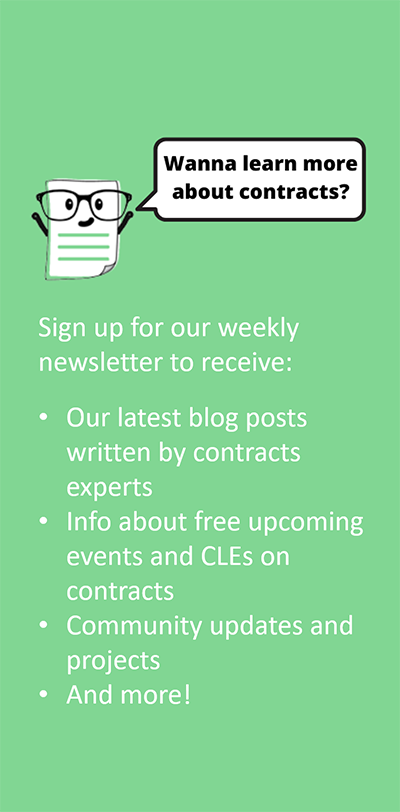
 Now that you’ve exchanged redlines with your counterparty, it is time to switch to live negotiations via a phone call or virtual meeting. The goal of the contract negotiation call is to close out the remaining open items and move the contract forward towards a final agreement.
Now that you’ve exchanged redlines with your counterparty, it is time to switch to live negotiations via a phone call or virtual meeting. The goal of the contract negotiation call is to close out the remaining open items and move the contract forward towards a final agreement.
How can you run the call as efficiently as possible to achieve this goal? It’s simple.
After all, contract negotiation calls are important business meetings. As the contract negotiator, the business counterparts look to you to help drive negotiations forward. Therefore, you will most likely be the meeting organizer and the meeting leader, which means the success of the call is in your hands. To achieve maximum efficiency in your contract negotiation calls, follow these guidelines, which are inspired by project management principles.
Never include more people than necessary on a contract negotiation call because having too many cooks in the kitchen will result in a less efficient discussion. At a minimum, include legal and business counterparts from both sides, and maybe a stakeholder or two. Invite stakeholders that can make decisions or subject matter experts that can contribute to the discussion. Don’t invite more than one person from the same team or function. There should be no more than six people on a contract negotiation call (unless you’re working on a merger and acquisition or other similarly complex or high-profile deal).
Believe it or not, I was recently invited to a standard customer-vendor commercial contract negotiation call that had 15 other invitees. That’s 16 people, including myself! I immediately reached out to the organizer and politely explained that 16 people was about 10 too many for this type of call. The vendor hadn’t realized how quickly the invites had added up and was happy to accommodate. We ended up having a very productive call with just six people.
Note-to-self: People are not always intentional or strategic about who they invite to a call, but you should be.
Every proper business meeting has an agenda to help organize the discussion. In the case of a contract negotiation call, the agenda is primarily dictated by the remaining redlines. You can start by summarizing high-level issues and then diving into the details. See below for an example agenda.
When reviewing redlines, the presenter should share his or her screen with the meeting attendees so that everyone is looking at the same version. Note to self: Make sure you use an external-friendly version during the meeting to avoid exposing confidential or attorney-client privileged communications.
Discuss which approach works better for everyone on the call: 1) going through each redline from top to bottom, or 2) jumping to the more complex open items. You can generally skip things like formatting changes or self-explanatory items.

Typically, whoever last received the latest round of redlines should be running the call and presenting the remaining redlines. For example, if you sent the latest redlines within a reasonable time before the call, then it is safe to expect that the other party had a chance to review it and will be prepared to share their feedback. If, however, you sent your redlines within 24-hours of the call, then you should not assume the other party had time to prepare. Instead, you should be ready to take the lead on the call.
Whether you’re taking the lead or along for the ride, you should review the latest draft before the call so it is fresh in your mind. There is nothing more frustrating than negotiating with someone who says, “Sorry, I haven’t read the contract recently. What services are being provided?” Or, “My apologies, I didn’t have a chance to review your redlines. Can you walk through all of them?” If you’re not ready for a call, then reschedule it. Attending a call unprepared is not only inefficient, but it can also decrease your leverage and make you look incompetent.
Another way to be prepared is to meet with your internal business clients prior to the call to align on strategy, deal-breakers, and negotiation priorities. I was once on a call where the in-house counsel and business counterpart were so misaligned that they proceeded to argue with one another on the call. Yikes!
Regardless of who is leading the call, both contract negotiators should be taking diligent notes during the contract negotiation call. Your notes should include: 1) decisions made, and 2) action items.
When a decision is made, the lead contract negotiator should try to make live changes to the document while in screen sharing mode to get consensus on the language during the call. Draft the new language in Track Changes and ask, “Does this language look acceptable to you?” This helps get buy-in from opposing counsel right then and there. Note on the side, “As agreed on 8/4 call…”
If you said you would double-check the proposed change to the insurance clause with your insurance specialist, then note down this action item and assign it to yourself with a deadline. If the other party said they would check with their head of sales to see if they can offer a better discount, then jot down that action item so that you can follow up in a couple of days.
Before hanging up, confirm who is turning around the next draft and…now this is key…by when. Usually, the lead contract negotiator should be the one turning over the next set of redlines. But before that can happen, are there internal decisions that need to be made? Is there a document you need from the other party to complete your review? Keeping action items and decisions made on the call in mind, determine a reasonable timeframe and commit to it.
* * *
If you love our series on contract redlining etiquette, click here to sign-up for alerts on the upcoming book on Contract Redlining Etiquette™ by Nada Alnajafi.

Turn off Microsoft Word’s Modern Comments in a few easy steps.

Understanding creator’s rights and the influencer marketing industry as a whole, will be pivotal to facilitating effective negotiations that lead to win-win brand partnerships.

Embracing a thoughtful contract design, focused on engagement models that emphasize autonomy, can significantly reduce the risk of reclassification.

Even though SOW requirements are usually drafted and approved by business folks, legal teams can add value.
Follow Contract Nerds
© 2022 Contract Nerds United, LLC. All rights reserved.
The opinions expressed throughout this website are not intended to provide legal advice or create an attorney-client relationship.
Follow Contract Nerds
© 2022 Contract Nerds United, LLC. All rights reserved.
The opinions expressed throughout this website are not intended to provide legal advice or create an attorney-client relationship.

By subscribing to our newsletter, you agree to our Terms of Use and Privacy Policy. We promise not to spam you!

One Response